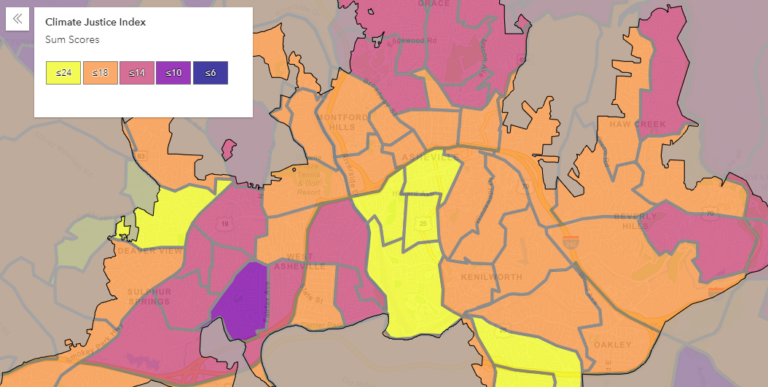Climate Justice tools and resources can help operationalize lessons and information gathered in “clear skies” times to react and respond with informed, data driven actions during times of stress and crisis.
Reports and data sets from the multi-year process of analyzing Asheville’s climate threats and assets, interviewing community members and hosting community conversations culminated in lengthy, dense documents. The Climate Justice Data Map seeks to combine this information alongside “non climate stressors” such as red-lining, energy burden and social vulnerability to provide a quick go-to resource for use both in times of long term project planning and for quick reaction needs.
During the December of 2022 water outage, the Climate Justice Data Map came out of the toolbox and aided in getting drinking water delivered directly to our most vulnerable neighbors. The City’s Communication and Public Engagement (CAPE) team analyzed the Climate Justice Data Map beside water outage data to better identify and strategize equitable water distribution. CAPE then worked with the Fire Department to get drinking water into the hands of water customers quickly and efficiently with equity and access in mind, which would not have been possible without the Climate Justice data.
A quick overlay (thanks IT!) allowed these multiple data points to inform efficient strategies to prioritize getting water into the hands of our most vulnerable neighbors by designating pick up locations that were in close proximity to the intersection of high Climate Justice Index scores and outage sites. CAPE and Fire department staff contacted neighborhood leaders and community center staff to coordinate water drop off points and get the word out to residents.
Jeremy Knighton, Division Chief in Emergency Management/Special Operations noted, “From an emergency management perspective it was invaluable to have Climate Justice tools at our fingertips to do our best, most equitable work without compromising efficient response to get emergency resources into our communities as quickly as possible.”
Many departments collaborated in this thoughtful execution of multiple resources. CAPE’s Neighborhood Services team, IT, Fire, Parks and Recreation, Water and more combined ideas and action to respond to a crisis that impacted many in our community.
By identifying our more vulnerable communities, the Climate Justice data map guides the City in building stronger connections with neighborhoods who, in the moment of an environmental incident or crisis, might be at the forefront of the impact. While we hope to never repeat such a widespread holiday season outage, the City continues to work to prevent and prepare for emergencies. Response strategy matters and this is an example of a practical application where climate justice data can inform projects and programs in our community.
